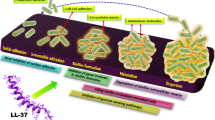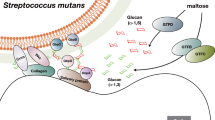Abstract
The emergence of infections caused by microorganisms in the oral cavity and increasing concerns regarding the use of antibiotics have resulted in the development of novel antimicrobial molecules, such as antimicrobial synthetic peptides. The purpose of this study was to evaluate the antimicrobial and antibiofilm activities of the native peptide KR-12 and its derivative, the synthetic peptide [W7]KR12-KAEK, against planktonic and biofilms Enterococcus faecalis strains. The methods used to evaluate the antimicrobial activity in planktonic cultures include minimum inhibitory concentration and minimum bactericidal concentration assays. The effects of [W7]KR12-KAEK on biofilm formation and mature biofilms were evaluated by quantifying biomass (crystal violet staining) and counting colony-forming units. Structural assessments of the biofilms and cellular morphological changes were performed using scanning electron microscopy. Peptide [W7]KR12-KAEK showed potential antimicrobial activity against planktonic cells. Interestingly, the native peptide KR-12 showed no antimicrobial activity. Moreover, it inhibited biofilm formation and disrupted the mature biofilms of E. faecalis strains. These results suggest that [W7]KR12-KAEK may be a potential molecule for the development of auxiliary antimicrobial therapies against oral infections.





Similar content being viewed by others
References
Pak JG, Fayazi S, White SN (2012) Prevalence of periapical radiolucency and root canal treatment: a systematic review of cross-sectional studies. J Endod 38(9):1170–1176. https://doi.org/10.1016/j.joen.2012.05.023
Venkateshbabu N, Anand S, Abarajithan M, Sheriff SO, Jacob PS, Sonia N (2016) Natural therapeutic options in endodontics—a review. Open Dent J 10(1):214–226. https://doi.org/10.2174/1874210601610010214
Sundqvist G (1992) Ecology of the root canal flora. J Endod 18(9):427–430. https://doi.org/10.1016/S0099-2399(06)80842-3
Kassen R, Rainey PB (2004) The ecology and genetics of microbial diversity. Annu Rev Microbiol 58:207–231. https://doi.org/10.1146/annurev.micro.58.030603.123654
Raskin DM, Seshadri R, Pukatzki SU, Mekalanos JJ (2006) Bacterial genomics and pathogen evolution. Cell 124(4):703–714. https://doi.org/10.1016/j.cell.2006.02.002
Molander A, Reit C, Dahlen G, Kvist T (1998) Microbiological status of root-filled teeth with apical periodontitis. Int Endontic J 31(1):1–7. https://doi.org/10.1046/j.1365-2591.1998.t01-1-00111.x
Peciuliene V, Balciuniene I, Eriksen HM, Haapasalo M (2000) Isolation of Enterococcus faecalis in previously root-filled canals in a Lithuanian population. J Endod 26(10):593–595. https://doi.org/10.1097/00004770-200010000-00004
Gomes BP, Pinheiro ET, Sousa EL, Jacinto RC, Zaia AA, Ferraz CCR, de Souza-Filho FJ (2006) Enterococcus faecalis in dental root canals detected by culture and by polymerase chain reaction analysis. Oral Surg Oral Med Oral Pathol Oral Radiol Endod 102(2):247–253. https://doi.org/10.1016/j.tripleo.2005.11.031
Rôças IN, Siqueira JF, Santos K (2004) Association of Enterococcus faecalis with different forms of periradicular diseases. J Endod 30(5):315–320. https://doi.org/10.1097/00004770-200405000-00004
Stuart CH, Schwartz SA, Beeson TJ, Owatz CB (2006) Enterococcus faecalis: its role in root canal treatment failure and current concepts in retreatment. J Endod 32(2):93–98. https://doi.org/10.1016/j.joen.2005.10.049
Darcey J, Jawad S, Taylor C, Roudsari RV, Hunter M (2015) Modern endodontic principles part 4: irrigation. Dent Update 43(1):20–22. https://doi.org/10.12968/denu.2016.43.1.20
Plotino G, Cortese T, Grande NM, Leonardi DP, Di Giorgio G, Testarelli L, Gambarini G (2016) New technologies to improve root canal disinfection. Braz Dent J 27(1):3–8. https://doi.org/10.1590/0103-6440201600726
Dunavant TR, Regan JD, Glickman GN, Solomon ES, Honeyman AL (2006) Comparative evaluation of endodontic irrigants against Enterococcus faecalis biofilms. J Endod 32(6):527–531. https://doi.org/10.1016/j.joen.2005.09.001
Garlapati R, Venigalla BS, Surakanti JR, Thumu J, Chennamaneni KC, Kalluru RS (2016) Comparison of the antimicrobial efficacy of two antibiotics sparfloxacin and augmentin as experimental root canal irrigating solutions against Enterococcus faecalis-an in vitro study. J Clin Diagn Res 10(3):ZC57. https://doi.org/10.7860/JCDR/2016/17199.7470
Giardino L, Ambu E, Savoldi E, Rimondini R, Cassanelli C, Debbia EA (2007) Comparative evaluation of antimicrobial efficacy of sodium hypochlorite, MTAD, and Tetraclean against Enterococcus faecalis biofilm. J Endod 33(7):852–855. https://doi.org/10.1016/j.joen.2007.02.012
Gonçalves LS, Rodrigues RCV, Junior CVA, Soares RG, Vettore MV (2016) The effect of sodium hypochlorite and chlorhexidine as irrigant solutions for root canal disinfection: a systematic review of clinical trials. J Endod 42(4):527–532. https://doi.org/10.1016/j.joen.2015.12.021
GorrAbdolhosseini SUM (2011) Antimicrobial peptides and periodontal disease. J Clin Periodontol 38(s11):126–141. https://doi.org/10.1111/j.1600-051X.2010.01664.x
Zasloff M (2002) Antimicrobial peptides of multicellular organisms. Nature 415(6870):389–395. https://doi.org/10.1038/415389a
de Freitas Lima SM, de Pádua GM, da Costa Sousa MG, de Souza FM, Franco OL, Rezende TMB (2015) Antimicrobial peptide-based treatment for endodontic infections—biotechnological innovation in endodontics. Biotechnol Adv 33(1):203–213. https://doi.org/10.1016/j.biotechadv.2014.10.013
da Silva BR, de Freitas VAA, Nascimento-Neto LG, Carneiro VAVS, de Aguiar ASW, Cavada BS, Teixeira EH (2012) Antimicrobial peptide control of pathogenic microorganisms of the oral cavity: a review of the literature. Peptides 36(2):315–321. https://doi.org/10.1016/j.peptides.2012.05.015
Winfred SB, Meiyazagan G, Panda JJ, Nagendrababu V, Deivanayagam K, Chauhan VS, Venkatraman G (2014) Antimicrobial activity of cationic peptides in endodontic procedures. Eur J Dent 8(2):254. https://doi.org/10.4103/1305-7456.130626
Wang G (2008) Structures of human host defense cathelicidin LL-37 and its smallest antimicrobial peptide KR-12 in lipid micelles. J Biol Chem 283(47):32637–32643. https://doi.org/10.1074/jbc.M805533200
Mishra B, Epand RF, Epand RM, Wang G (2013) Structural location determines functional roles of the basic amino acids of KR-12, the smallest antimicrobial peptide from human cathelicidin LL-37. RSC Adv 3(42):19560–19571. https://doi.org/10.1039/C3RA42599A
Jacob B, Park IS, Bang JK, Shin SY (2013) Short KR-12 analogs designed from human cathelicidin LL-37 possessing both antimicrobial and antiendotoxic activities without mammalian cell toxicity. J Pept Sci 19(11):700–707. https://doi.org/10.1002/psc.2552
da Silva BR, Conrado AJS, Pereira AL, Evaristo FFV, Arruda FVS, Vasconcelos MA, Lorenzón EN, Cilli EM, Teixeira EH (2017) Antibacterial activity of a novel antimicrobial peptide [W7]KR12-KAEK derived from KR-12 against Streptococcus mutans planktonic cells and biofilms. Biofouling 33(10):835–846. https://doi.org/10.1080/08927014.2017.1374378
Stepanović S, Vuković D, Dakić I, Savić B, Švabić-Vlahović M (2000) A modified microtiter-plate test for quantification of staphylococcal biofilm formation. J Microbiol Methods 40(2):175–179. https://doi.org/10.1016/S0167-7012(00)00122-6
Vasconcelos MA, Arruda FVS, Santos HS, Rodrigues AS, Bandeira PN, Albuquerque MRJR, Cavada BS, Teixeira EH, Henriques M, Pereira MO (2014) Effect of a casbane diterpene isolated from Croton nepetaefolius on the prevention and control of biofilms formed by bacteria and Candida species. Ind Crops Prod 61:499–509. https://doi.org/10.1016/j.indcrop.2014.07.027
Zero DT, Zandona AF, Vail MM, Spolnik KJ (2011) Dental caries and pulpal disease. Dent Clin North Am 55(1):29–46. https://doi.org/10.1016/j.cden.2010.08.010
Pujar M, Makandar SD (2011) Herbal usage in endodontics—a review. Int J Contemp Dent 2(1):34–37
Thennarasu S, Tan A, Penumatchu R, Shelburne CE, Heyl DL, Ramamoorthy A (2010) Antimicrobial and membrane disrupting activities of a peptide derived from the human cathelicidin antimicrobial peptide LL37. Biophys J 98(2):248–257. https://doi.org/10.1016/j.bpj.2009.09.060
Lee SH, Baek DH (2012) Antibacterial and neutralizing effect of human β-defensins on Enterococcus faecalis and Enterococcus faecalis lipoteichoic acid. J Endod 38(3):351–356. https://doi.org/10.1016/j.joen.2011.12.026
Chan DI, Prenner EJ, Vogel HJ (2006) Tryptophan- and arginine rich antimicrobial peptides: structures and mechanisms of action. Biochim Biophys Acta Biomembr 1758:1184–1202. https://doi.org/10.1016/j.bbamem.2006.04.006
Crusca E, Rezende AA, Marchetto R, Mendes-Giannini MJ, Fontes W, Castro MS, Cilli EM (2011) Influence of N-Terminus modifications on the biological activity, membrane interaction, and secondary structure of the antimicrobial peptide Hylin-a1. Pept Sci 96:41–48. https://doi.org/10.1002/bip.21454
Mikut R, Ruden S, Reischl M, Breitling F, Volkmer R (1858) Hilpert K (2016) Improving short antimicrobial peptides despite elusive rules for activity. Biochim Biophys Acta Biomembr 5:1024–1033. https://doi.org/10.1016/j.bbamem.2015.12.013
da Silva BR, De Freitas VAA, Carneiro VA, Arruda FVS, Lorenzón EN, De Aguiar ASW, Cilli EM, Cavada BS, Teixeira EH (2013) Antimicrobial activity of the synthetic peptide Lys-a1 against oral streptococci. Peptides 42:78–83. https://doi.org/10.1016/j.peptides.2012.12.001
Ramesh S, Govender T, Kruger HG, Torre BG, Albericio F (2016) Short antimicrobial peptides (SAMPs) as a class of extraordinary promising therapeutic agents. J Pept Sci 22(7):438–451. https://doi.org/10.1002/psc.2894
Barber KE, Werth BJ, McRoberts JP, Rybak MJ (2014) A novel approach utilizing biofilm time-kill curves to assess the bactericidal activity of ceftaroline combinations against biofilm-producing methicillin-resistant Staphylococcus aureus. Antimicrob Agents Chemother 58(5):2989–2992. https://doi.org/10.1128/AAC.02764-13
Fisher K, Phillips C (2009) The ecology, epidemiology and virulence of Enterococcus. Microbiology 155(6):1749–1757. https://doi.org/10.1099/mic.0.026385-0
Upadhyaya GP, Lingadevaru UB, Lingegowda RK (2010) Comparative study among clinical and commensal isolates of Enterococcus faecalis for presence of esp gene and biofilm production. J Infect Dev Ctries 5(5):365–369. https://doi.org/10.3855/jidc.1385
Niu JY, Yin IX, Wu WKK, Li QL, Mei ML, Chu CH (2021) Antimicrobial peptides for the prevention and treatment of dental caries: a concise review. Arch Oral Biol 122:105022. https://doi.org/10.1016/j.archoralbio
Zhang OL, Niu JY, Yin IX, Yu OY, Mei ML, Chu CH (2022) Growing global research interest in antimicrobial peptides for caries management: a bibliometric analysis. J Funct Biomater 13(4):210. https://doi.org/10.3390/jfb13040210
Ahn KB, Kim AR, Kum KY, Yun CH, Han SH (2017) The synthetic human beta-defensin-3 C15 peptide exhibits antimicrobial activity against Streptococcus mutans, both alone and in combination with dental disinfectants. J Microbiol 55(10):830–836. https://doi.org/10.1007/s12275-017-7362-y
Zhuo H, Zhang X, Li M, Zhang Q, Wang Y (2022) Antibacterial and anti-inflammatory properties of a novel antimicrobial peptide derived from LL-37. Antibiotics (Basel) 11(6):754. https://doi.org/10.3390/antibiotics11060754
Caiaffa KS, Dos Santos VR, Abuna GF, Santos-Filho NA, Cilli EM, Sakai VT, Cintra LTA, Duque C (2021) Cytocompatibility and synergy of EGCG and cationic peptides against bacteria related to endodontic infections, in planktonic and biofilm conditions. Probiotics Antimicrob Proteins 13(6):1808–1819. https://doi.org/10.1007/s12602-021-09830-3
Brogden KA (2005) Antimicrobial peptides: pore formers or metabolic inhibitors in bacteria? Nat Rev Microbiol 3(3):238–250. https://doi.org/10.1038/nrmicro1098
Paulsen VS, Blencke HM, Benincasa M, Haug T, Eksteen JJ, Styrvold OB, Schocchi M, Stensvåg K (2013) Structure-activity relationships of the antimicrobial peptide arasin 1—and mode of action studies of the N-terminal, proline-rich region. PLoS ONE 8(1):e53326. https://doi.org/10.1371/journal.pone.0053326
Futaki S, Suzuki T, Ohashi W, Yagami T, Tanaka S, Ueda K, Sugiura Y (2001) Arginine-rich peptides an abundant source of membrane-permeable peptides having potential as carriers for intracellular protein delivery. J Biol Chem 276(8):5836–5840. https://doi.org/10.1074/jbc.M007540200
Richard JP, Melikov K, Vives E, Ramos C, Verbeure B, Gait MJ, Chernomordik LV, Lebleu B (2003) Cell-penetrating peptides A reevaluation of the mechanism of cellular uptake. J Biol Chem 278(1):585–590. https://doi.org/10.1074/jbc.M209548200
Wadia JS, Stan RV, Dowdy SF (2004) Transducible TAT-HA fusogenic peptide enhances escape of TAT-fusion proteins after lipid raft micropinocytosis. Nat Med 10(3):310–315. https://doi.org/10.1038/nm996
Acknowledgements
The authors are grateful to Central Analítica-UFC/CT-INFRA/MCTI-SISNANO/Pró-Equipamentos CAPES. MAV are senior investigators at the UEMG. EMC and EHT are senior investigators at CNPq.
Funding
This research was funded by FAPEMIG (Grant No. APQ-00224-2 to Mayron Alves de Vasconcelos).
Author information
Authors and Affiliations
Contributions
MAV, BRS, ALA, AAP, FFVE and FVSA—Contributed to the antibacterial and antibiofilm activities and the writing of the manuscript. ENL and EMC contribute to peptide synthesis. MAV, EHT, and EMC—Contributed to the data analysis, critical reading and drafting of the manuscript, study design, and laboratory work supervision.
Corresponding author
Ethics declarations
Conflict of interest
The authors declare no conflict of interest.
Ethical Approval
Not applicable.
Consent to Participate
Not applicable.
Consent for Publication
Not applicable.
Data Availability
All data and material are available with corresponding author.
Code Availability
Not applicable.
Additional information
Publisher's Note
Springer Nature remains neutral with regard to jurisdictional claims in published maps and institutional affiliations.
Rights and permissions
Springer Nature or its licensor (e.g. a society or other partner) holds exclusive rights to this article under a publishing agreement with the author(s) or other rightsholder(s); author self-archiving of the accepted manuscript version of this article is solely governed by the terms of such publishing agreement and applicable law.
About this article
Cite this article
Vasconcelos, M.A., da Silva, B.R., Andrade, A.L. et al. Antimicrobial and Antibiofilm Activity of Synthetic Peptide [W7]KR12-KAEK Against Enterococcus faecalis Strains. Curr Microbiol 80, 325 (2023). https://doi.org/10.1007/s00284-023-03445-3
Received:
Accepted:
Published:
DOI: https://doi.org/10.1007/s00284-023-03445-3




